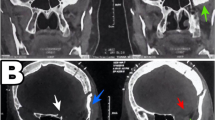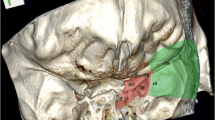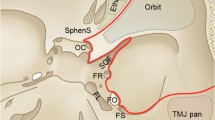Abstract
Background
Although meningiomas of the spheno-orbital region commonly result in hyperostosis, intraosseous meningiomas, which feature extensive full thickness infiltration of the anterolateral skull base, are rare. In this study, we assess the value of image guidance during surgery for intraosseous spheno-orbital skull-base meningiomas in achieving safe and maximal abnormal bone resection.
Method
Only cases with a full thickness and extensive intraosseous component were included. Image guidance was used to guide drilling of hyperostotic bone. Extensive resulting defects of the orbital wall were reconstructed with titanium mesh. Post-operative CT scans were used to assess completeness of abnormal bone resection in the skull base, and MRI scans used to evaluate residual intradural disease. Operative complications to neurovascular structures in adjacent foramina were recorded.
Results
Nineteen patients with full-thickness intraosseous spheno-orbital meningiomas underwent image-guided resection. Anterior clinoidectomy to variable extent was necessary in 11 cases with decompression of the optic canal in five. In ten cases, hyperostotic bone was drilled from the middle fossa around the exit foramina of the trigeminal nerve and base of the pterygoid plates. Proptosis was corrected in all cases, and of 11 patients presenting with reduced visual acuity, symptoms improved or stabilized in ten cases. Post-operative CT scans confirmed gross resection of abnormal bone in all cases, but limited residual tumor was present around the cavernous sinus or orbital apex in eight patients. One patient died from a pulmonary embolism, the only mortality of the series. One patient had worsening of pre-existing poor visual acuity, and three patients had worsening of pre-existing ophthalmoplegia. Five patients developed new facial numbness post-operatively, which persisted in three cases.
Conclusions
Intra-operative image guidance allowed total or near-total resection of the hyperostotic skull base around the cranial nerve foramina with minimal morbidity in a group of patients with extensive spheno-orbital meningiomas.

Similar content being viewed by others
References
Arana E, Diaz C, Latorre FF, Menor F, Revert A, Beltran A, Navarro M (1996) Primary intraosseous meningiomas. Acta Radiol 37(6):937–942
Behari S, Giri PJ, Shukla D, Jain VK, Banerji D (2008) Surgical strategies for giant medial sphenoid wing meningiomas: a new scoring system for predicting extent of resection. Acta Neurochir (Wien) 150(9):865–877, discussion 877
Bikmaz K, Mrak R, Al-Mefty O (2007) Management of bone-invasive, hyperostotic sphenoid wing meningiomas. J Neurosurg 107(5):905–912
Bonnal J, Thibaut A, Brotchi J, Born J (1980) Invading meningiomas of the sphenoid ridge. J Neurosurg 53(5):587–599
Changhong L, Naiyin C, Yuehuan G, Lianzhong Z (1997) Primary intraosseous meningiomas of the skull. Clin Radiol 52(7):546–549
Cirak B, Guven MB, Ugras S, Kutluhan A, Unal O (2000) Fronto-orbitonasal intradiploic meningioma in a child. Pediatr Neurosurg 32(1):48–51
De Jesus O, Toledo MM (2001) Surgical management of meningioma en plaque of the sphenoid ridge. Surg Neurol 55(5):265–269
Elder JB, Atkinson R, Zee CS, Chen TC (2007) Primary intraosseous meningioma. Neurosurg Focus 23(4):E13
Girkin CA, Comey CH, Lunsford LD, Goodman ML, Kline LB (1997) Radiation optic neuropathy after stereotactic radiosurgery. Ophthalmology 104(10):1634–1643
Jung HW, Yoo H, Paek SH, Choi KS (2000) Long-term outcome and growth rate of subtotally resected petroclival meningiomas: experience with 38 cases. Neurosurgery 46(3):567–574, discussion 574–565
Lang FF, Macdonald OK, Fuller GN, DeMonte F (2000) Primary extradural meningiomas: a report on nine cases and review of the literature from the era of computerized tomography scanning. J Neurosurg 93(6):940–950
Little KM, Friedman AH, Sampson JH, Wanibuchi M, Fukushima T (2005) Surgical management of petroclival meningiomas: defining resection goals based on risk of neurological morbidity and tumor recurrence rates in 137 patients. Neurosurgery 56(3):546–559, discussion 546–559
Margalit NS, Lesser JB, Moche J, Sen C (2003) Meningiomas involving the optic nerve: technical aspects and outcomes for a series of 50 patients. Neurosurgery 53(3):523–532, discussion 532–523
Maroon JC, Kennerdell JS, Vidovich DV, Abla A, Sternau L (1994) Recurrent spheno-orbital meningioma. J Neurosurg 80(2):202–208
Min JH, Kang SH, Lee JB, Chung YG, Lee HK (2005) Hyperostotic meningioma with minimal tumor invasion into the skull. Neurol Med Chir (Tokyo) 45(9):480–483
Pamir MN, Belirgen M, Ozduman K, Kilic T, Ozek M (2008) Anterior clinoidal meningiomas: analysis of 43 consecutive surgically treated cases. Acta Neurochir (Wien) 150(7):625–635, discussion 635–626
Pieper DR, Al-Mefty O (1999) Management of intracranial meningiomas secondarily involving the infratemporal fossa: radiographic characteristics, pattern of tumor invasion, and surgical implications. Neurosurgery 45(2):231–237, discussion 237–238
Pieper DR, Al-Mefty O, Hanada Y, Buechner D (1999) Hyperostosis associated with meningioma of the cranial base: secondary changes or tumor invasion. Neurosurgery 44(4):742–746, discussion 746–747
Pompili A, Derome PJ, Visot A, Guiot G (1982) Hyperostosing meningiomas of the sphenoid ridge–clinical features, surgical therapy, and long-term observations: review of 49 cases. Surg Neurol 17(6):411–416
Reinges MH, Nguyen HH, Krings T, Hutter BO, Rohde V, Gilsbach JM (2004) Course of brain shift during microsurgical resection of supratentorial cerebral lesions: limits of conventional neuronavigation. Acta Neurochir (Wien) 146(4):369–377, discussion 377
Ringel F, Cedzich C, Schramm J (2007) Microsurgical technique and results of a series of 63 spheno-orbital meningiomas. Neurosurgery 60(4 Suppl 2):214–221, discussion 221–212
Roser F, Nakamura M, Jacobs C, Vorkapic P, Samii M (2005) Sphenoid wing meningiomas with osseous involvement. Surg Neurol 64(1):37–43, discussion 43
Sade B, Lee JH (2008) High incidence of optic canal involvement in clinoidal meningiomas: rationale for aggressive skull base approach. Acta Neurochir (Wien) 150(11):1127–1132, discussion 1132
Scarone P, Leclerq D, Heran F, Robert G (2009) Long-term results with exophthalmos in a surgical series of 30 sphenoorbital meningiomas. Clinical article J Neurosurg 111(5):1069–1077
Schick U, Bleyen J, Bani A, Hassler W (2006) Management of meningiomas en plaque of the sphenoid wing. J Neurosurg 104(2):208–214
Shrivastava RK, Sen C, Costantino PD, Della Rocca R (2005) Sphenoorbital meningiomas: surgical limitations and lessons learned in their long-term management. J Neurosurg 103(3):491–497
Simpson D (1957) The recurrence of intracranial meningiomas after surgical treatment. J Neurol Neurosurg Psychiatry 20(1):22–39
Conflicts of interest
None.
Disclosure of funding
None.
Author information
Authors and Affiliations
Corresponding author
Additional information
Previous presentation: Interim findings of this study were presented at the European Congress of Neurosurgery, Glasgow, September 2007, and the Annual Meeting of the British Skull Base Society, London, January 2008
Rights and permissions
About this article
Cite this article
Marcus, H., Schwindack, C., Santarius, T. et al. Image-guided resection of spheno-orbital skull-base meningiomas with predominant intraosseous component. Acta Neurochir 155, 981–988 (2013). https://doi.org/10.1007/s00701-013-1662-8
Received:
Accepted:
Published:
Issue Date:
DOI: https://doi.org/10.1007/s00701-013-1662-8




